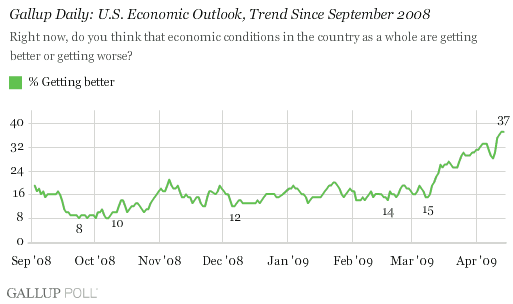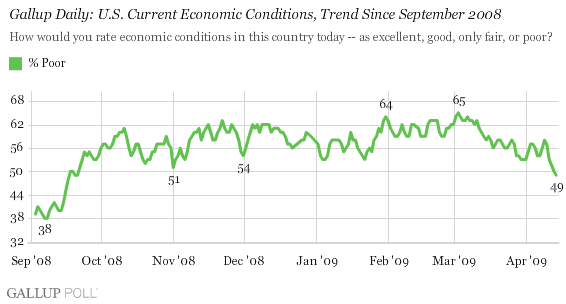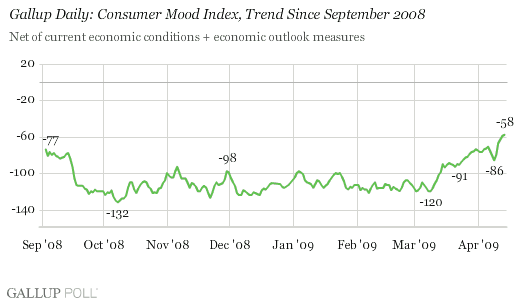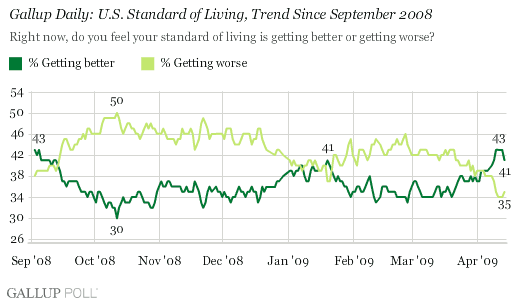WASHINGTON, D.C. -- Several key Gallup economic measures suggest Americans are now more positive about the economy than they have been at any point since the financial crisis escalated in mid-September 2008. The 37% of Americans who in April 11-14 polling say economic conditions are getting better is not only the best showing since September but also the most positive since Gallup began tracking the economic outlook daily in January 2008.

The 49% who describe current conditions as poor is the least negative reading since mid-September.

Gallup's Consumer Mood Index -- which is the net positive result of the economic conditions and economic outlook measures -- captures the improvement in Americans' overall economic views. That Index now stands at -58, the best since early January 2008 and a sharp improvement from the -120 showing recorded as recently as early March.

Americans Feeling Improvements at the Personal Level as Well
In addition to their improved views about the overall U.S. economy, Americans are also feeling better about their own economic situations. Over the past week, Gallup has consistently found more Americans saying their standard of living is getting better than saying it is getting worse -- including 41% vs. 35%, respectively, in the most recent reading. The 43% "getting better" percentage recorded through much of the past week matches the percentage last seen at the start of September 2008.

Examining the full trend on this standard-of-living measure, Gallup has not seen "getting better" responses consistently eclipse "getting worse" since last summer, when gas prices started to fall from peak levels.
Despite these positive signs, Gallup Poll Daily tracking results gauging employees' views of the jobs situation at their places of work and consumer spending remain decidedly negative, underscoring that there is a long way to go toward a true economic recovery. That said, the fact that Americans are increasingly positive about their personal standard of living suggests that the more nebulous elements of consumer psychology may begin to translate to tangible results. It will be crucial to monitor Gallup's job-market and consumer-spending data in the weeks and months ahead, to detect improvements in more traditional economic data, such as unemployment and retail sales. It is clear that, at least for now, Americans see the road ahead through a rosier lens than they did even a month ago.
Be sure to track each of these measures daily in the ticker at the top of Gallup.com.
Survey Methods
Results are based on telephone interviews conducted with 1,000 national adults, aged 18 and older, daily from Sept. 1, 2008, to April 14, 2009. The most recent results are from April 11-14, 2009, polling. Each individual result is based on a three-day rolling average. For each three-day sample, one can say with 95% confidence that the maximum margin of sampling error is ±3 percentage points.
Interviews are conducted with respondents on land-line telephones (for respondents with a land-line telephone) and cellular phones (for respondents who are cell-phone only).
In addition to sampling error, question wording and practical difficulties in conducting surveys can introduce error or bias into the findings of public opinion polls.
